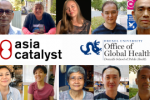By Mike Frick
One of the first thing many visitors to Beijing notice is the smog, which on bad days can obscure buildings, force people to stay indoors or even ground planes at Beijing’s Capital Airport. In a new piece in The Guardian, Zhong Nanshan, President of the China Medical Association, said that air pollution will soon become the biggest health threat in China.
According to the World Health Organization, outdoor and indoor air pollution cause up to 300,000 and 550,000 deaths respectively per year in China, and contribute to many cases of avoidable illness and days lost from work.
Recent debate about air pollution in China has largely focused on measurement of PM2.5 particles, or fine particulate matter from dust, smoke and other air-borne pollutants that, because of their small size, penetrate deeply into the lungs. Researchers have associated long-term exposure to high concentrations of fine particulate matter with lung cancer and chronic respiratory conditions. As some visitors find, even short-term exposure can aggravate asthma or increase the risk of respiratory infections.
Although PM2.5 can originate from many sources, the so-called “three Cs” – cars, construction and coal – together account for much of the air pollution in Chinese urban centers. Until recently, the Chinese government only tracked larger PM10 particles, which pose less risk to respiratory health. On March 1, 2012, the Chinese State Council ordered 27 provincial capitals and other major cities to begin tracking PM2.5 concentrations, with plans to expand these stronger monitoring standards to an additional 113 cities by 2013.
Accessing health information such as PM2.5 readings remains a sensitive issue in China, where epidemics are considered state secrets. But access to this kind of information is central to the right to health as articulated in the International Covenant on Economic, Social and Cultural Rights, which China has signed and ratified. In General Comment 14 on the Right to Health, the Committee on Economic, Social and Cultural Rights affirmed that the right to health includes “the right to seek, receive and impart information and ideas concerning health issues,” including environmental conditions.
In his article, Zhong Nanshan expressed cautious optimism that new reporting will produce better data on air pollution and its associated health burden. In fact, stronger monitoring and surveillance constitute just the first step in deveoping an evidence-based public health response to air pollution in China.
Actually reducing the health toll of air pollution in China will require that authorities act on such information to strengthen environmental protection and health policies. Creating tougher regulations on air pollution will be the next challenge.
Mike Frick is China Program Officer at Asia Catalyst.




